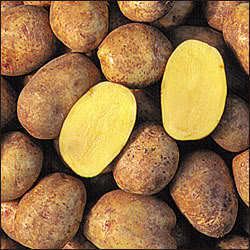Genus Solanum Hybrid parentage 'Norgleam' x W5279-4 Origin Ontario, Canada | Species Solanum tuberosum Cultivar 'Yukon Gold' | |
 | ||
Yukon Gold is a large variety of potato most distinctly characterized by its thin, smooth eye-free skin and yellow-tinged flesh. This potato was developed in the 1960s by G. R. Johnston, R.G. Rowberry, and Dr. Norman Thompson in Guelph, Ontario, Canada at the University of Guelph. The official cross was made in 1966 and the 'Yukon Gold' was finally released into the market in 1980.
Contents
Development and naming
In the 1900s, many Dutch and Belgian immigrants began settling in the “Banana Belt” region of southern Ontario. Many of these immigrants began vegetable farming around the towns of Simcoe, Leamington and Harrow along the shore of Lake Erie. In the 1950s the vegetable growers of this region began petitioning for the breeding rights and licensing for a yellow fleshed potato variety as they were used to growing in Europe. For Gary Johnston this began the nearly 30 year development of the 'Yukon Gold' Potato.
In 1953, Johnston was one of the scientists that owned the potato development lab at the Ontario Agriculture College at the University of Guelph. In 1959 one of Johnston’s graduate students, a young man originally from Peru, told him of a small, rough, deep yellowed flesh potato (Solanum gonicalix, known as papa amarilla, "yellow potato") that was grown by the indigenous communities in the Peruvian Andes. In Lima, this variety is a delicacy due to its bright color and distinct flavor. After trying these Peruvian potatoes, Johnston set out to breed a variety with the same color and flavor characteristics but larger in size and with a smoother shape, similar to the potatoes being grown in the Banana Belt. In 1966, the development team made their first cross between a W5289-4 (2x cross between 'Yema de huevo' and 2x Katahdin) and a 'Norgleam' potato native to North Dakota. After the 66th cross that year, true seed was produced and the G6666 was created.
Johnston initially named the variety “Yukon”, for the Yukon River and gold rush country in Northern Canada. Charlie Bishop suggested adding “Gold” to better reflect the color and appearance of the potato.
Cooking
Unlike some other potato varieties, the 'Yukon Gold' can stand up to both dry heat and wet heat cooking methods. Its waxy moist flesh and sweet flavour make it ideal for boiling, baking and frying but these potatoes will also withstand grilling, pan frying, and roasting.
One medium (150g) potato provides the following nutrition (percentages are based on a 2,000-calorie diet):
General features
Botanical features
Agricultural features
Susceptibility to disease
Very susceptible to, seed decay, blackleg, early blight, late blight, early dying, PVY, soft rot, dry rot, leak, pink rot, silver scurf and black scurf.
Susceptible to, common scab.
Moderately tolerant to, leaf roll.
Tolerant to, PVX.
Storage
This variety is resistant to bruising and does not sprout a lot due to the fact that it has good dormancy. If they are stored correctly they will not lose a lot of moisture compared to other varieties. It is important that the lenticels are not swollen and that the skin is not bruised because this can lead to major rot issues.
